20+ SAMPLE Affidavit of Transfer
-
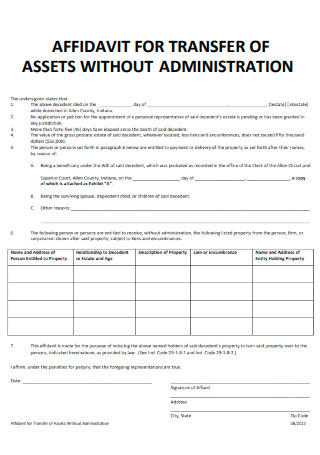
Affidavit for Transfer of Assets Without Administration
download now -
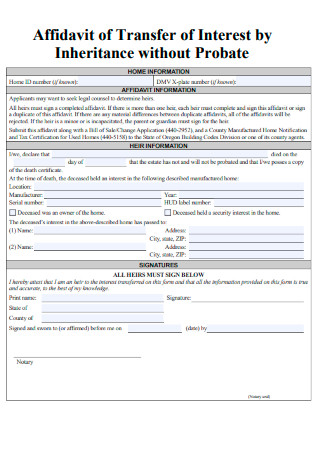
Affidavit of Transfer of Interest by Inheritance without Probate
download now -
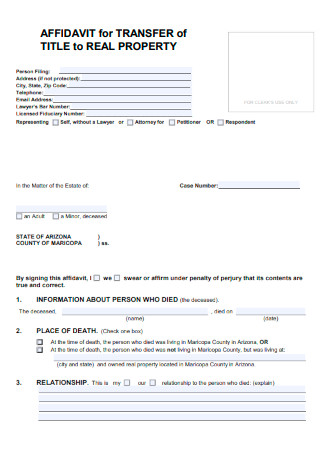
Affidavit for Transfer of Title to Real Property
download now -
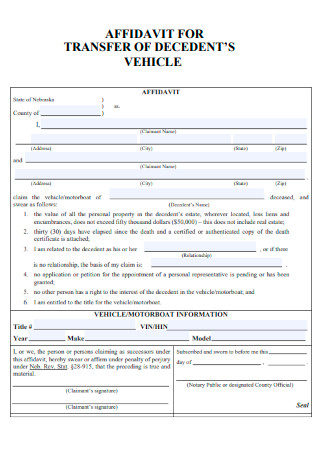
Affidavit for Transfer of Decedents Vehicle
download now -
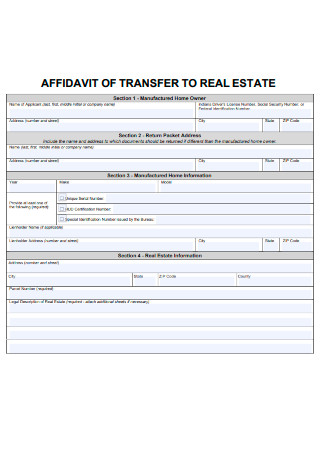
Affidavit of Transfer to Real Estate
download now -
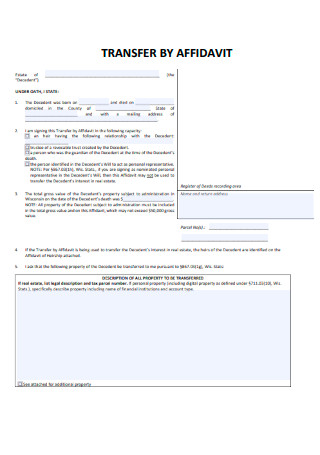
Transfer by Affidavit
download now -
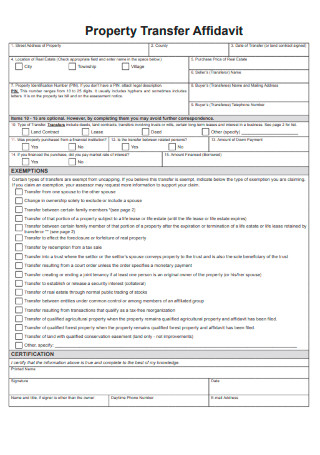
Property Transfer Affidavit
download now -

Deed Transfer Affidavit of Value
download now -

Transfer Certificate Deficiency Affidavit & Migration
download now -
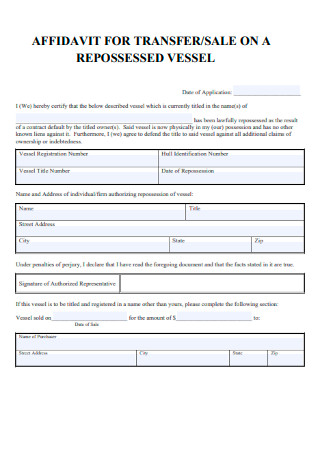
Affidavit for Transfer & Sale on a Repossessed Vessel
download now -
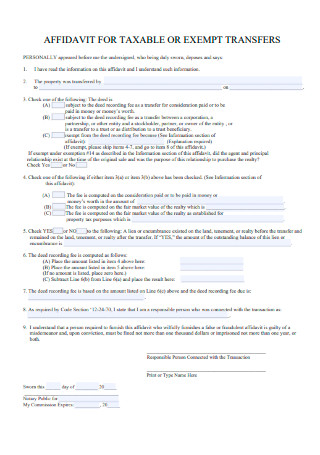
Affidavit for Taxable or Exempt Transfers
download now -
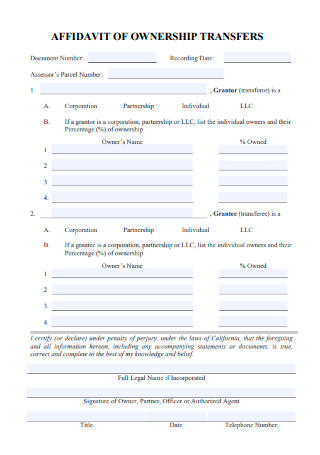
Affidavit of Ownership Transfers
download now -
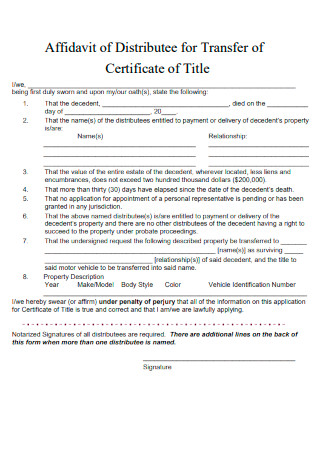
Affidavit of Distributee for Transfer of Certificate of Title
download now -

Certified Investor Tax Credit Transfer Affidavit
download now -

Transfer on Death Affidavit
download now -

Transfer of Tax Affidavit
download now -
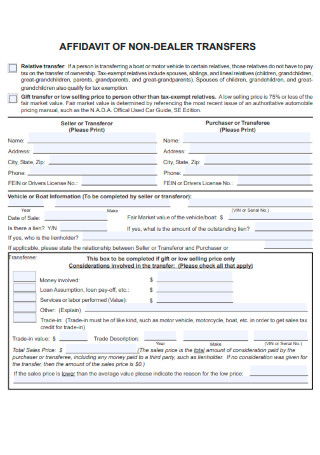
Affidavit of Non Dealer Transfer
download now -

Affidavit for Transfer of Assets
download now -
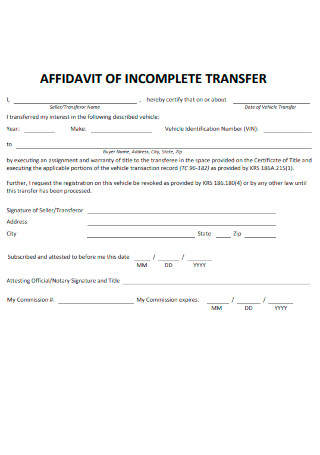
Affidavit of Incomplete Transfer
download now -
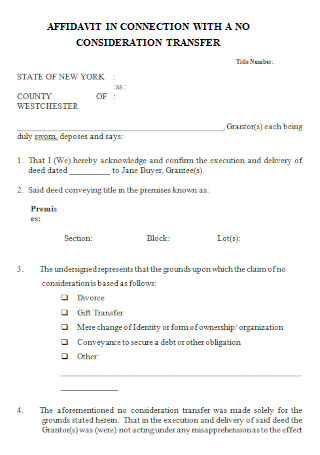
Affidavit in Connection with a no Consideration of Transfer
download now -
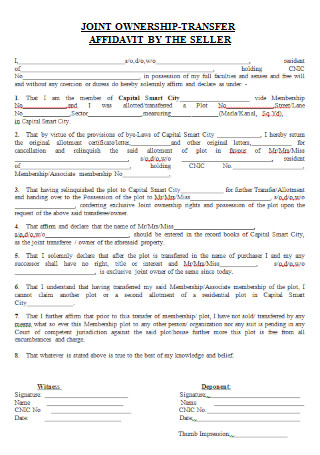
Joint Ownership Transfer Affidavit by Seller
download now
FREE Affidavit of Transfer s to Download
20+ SAMPLE Affidavit of Transfer
What Is Affidavit of Transfer?
What Is the Importance of Affidavit of Transfer?
How Does the Transfer Process Work?
6 Steps In Writing An Affidavit:
FAQs
What Happens on Filing of a False Affidavit?
When Do You Need to Write an Affidavit?
What Does the Transfer of Property Mean?
What Else Should a Person Know About the Transfer Process?
What Is Affidavit of Transfer?
An Affidavit of Transfer is a form that notifies the local taxing authority of a transfer of ownership of real estate. It is required by law, so that the local taxing authority knows (a) who owns the property, (b) where to send the tax bill, (c) whether the property is entitled to the lower “homestead” tax rate, and (d) whether it is time to adjust (or “uncap”) the property taxes. The law requires a new owner to file this within 45 days after a transfer of ownership. Generally, a transfer will cause the property taxes to be “uncapped,” but there are many exceptions to that rule. If you fall under one of those exceptions, and you select the correct exception on the form, you may be able to avoid a property tax increase.
A property transfer affidavit is a written legal document which must be filed whenever ownership of real property is transferred from one party to another. The affidavit is filed with the tax assessor’s office of the city or township where the property is located. This action allows the tax assessor to properly assess taxes on the property and to determine the taxable value of the real property.
Furthermore, information typically required to be disclosed on the form includes a legal identification of the property transferred, such as lot numbers and plate numbers; identification of the seller and the transferee or buyer; the date the transfer took place; and the amount of any currency exchanged in consideration of the transfer. Depending on the requirements of the city or township where the property is located, the property transfer affidavit may include other information regarding the transfer, as well. These requirements might include the property identification number, which usually can be found on the most recent property tax bill or assessment notice.
What Is the Importance of Affidavit of Transfer?
The new owner of the property is charged with the responsibility of filing this document in a timely manner. A new property owner typically must file the property transfer affidavit with the assessor for the city or township where the real property is located within 45 days of the transfer. If it is not filed in a timely manner, a cash penalty may be charged. The property transfer affidavit usually must be filed regardless of whether a property deed is filed or not.
It is especially important when a person purchases a bank owned or non-occupied home to be sure to file the property transfer affidavit as soon as the real property transfer is completed. Non-resident property taxes are typically much higher than those paid by the primary resident of the property. Therefore, it can be advantageous for the new owner, if he plans to use the property as his primary residence, to file this form to have the taxes reassessed at the new, much lower, resident rate.
Important Features of an Affidavit:
It should be in writing. Since an Affidavit is used as a record in court, it has to be in writing. This is to make the person who makes the affidavit accountable for the contents sworn in the affidavit. It also deters people from making false claims since they amount to punishable offences.
It must be a declaration made by an individual. An Affidavit can be created only by an individual, and not by any artificial persons like Companies and other associations or Groups of individuals.
It must be sworn before an officer or magistrate who is authorized to administer oath. An affidavit can be sworn only before a person having authority to attest it. For example, a name change affidavit may be attested either by a Notary Public or by an Executive or Judicial magistrate for documents created in India; while an affidavit for lost or damaged passport can be attested only by a Judicial or Executive Magistrate and it is beyond the authority of a Notary Public.
It must be made in the first person. Affidavits cannot be created on behalf of other persons. The purpose is to prevent declaring of things beyond the reasonable knowledge of a person. It is the duty of the deponent to state facts which are known to him/her. However, it is subject to the exception where affidavits are sworn on behalf of minor children or insane individuals.
It must relate to facts alone. An Affidavit should mention only the facts according to the best knowledge and belief of the deponent. It should not be based on mere inferences or assumptions.
How Does the Transfer Process Work?
The transfer process can take up to 3 months. There are different phases involved in the transfer of a property. These phases are:
6 Steps In Writing An Affidavit:
Since this is a legal document, there is a right way to write an affidavit. Most affidavits can be completed by any person but they must be notarized before they are considered valid. Below is the basic six-step process you will need to take to complete your affidavit.
Step 1: Title the Affidavit
First, you need to title your affidavit. The title of your affidavit just needs to tell the person reading it what your sworn statement is going to be about. Include both your name and the topic of the affidavit.
If your affidavit is being submitted before a court, you will need to include the caption of the case in this section as well. Your case caption can be found on any related court documents. It will include the name of the court, county and state, names of all parties involved, and your case number.
Step 2: Craft a Statement of Identity
The very next section of your affidavit is what’s known as a statement of identity. This is where you will include your personal information including your name, age, occupation, place of residence, and any other information relevant to the situation or case.
This section is used to preface who you are in relation to the facts you are about to outline. You don’t have to include your life story, but you do need to include any relevant information to the claims you are making.
Step 3: Write a Statement of Truth
This section of your affidavit is used to swear that your telling of the facts is accurate to the best of your knowledge. A statement of truth is the equivalent of swearing under oath in a courtroom.
Your statement of truth must be in the first person and you need to identify yourself in it. Keep it short and sweet. You are just acknowledging that you agree not to lie in your affidavit.
Step 4: State the Facts
Once you have all of that out of the way, it is time to state the facts. This section of the affidavit will likely be the longest. There is no certain length this section should be, it is just important that it includes all the accurate information. Here are some tips you can use to complete this section:
Stick to the Facts
Avoid injecting your personal opinion or observations into your affidavit. This isn’t the time for you to flex your storytelling skills. You need to keep the facts objective, clear, and concise. Your only job is to state the facts as you best remember them. Leave the interpretations to the lawyers. When you state these facts you’ll need to provide details such as names, dates, times, and addresses.
Outline your facts clearly
Create an outline of everything you remember about the situation and then determine which facts are relevant to your affidavit. Then, arrange them in a coherent manner. One of the best ways to arrange the facts about a situation is in chronological order.
Each fact should be its own separate paragraph and you should reference any supporting documents as exhibits within the corresponding paragraph. Number the paragraphs so that it is easy for the reader to follow.
Step 5: Reiterate your Statement of Truth
Once you have recounted all the facts, you will close everything out with another statement of truth. All you need to include is a quick summary that everything you’ve outlined above is true to the best of your knowledge.
This section does not need to be longer than a few sentences. You can tweak the language a bit, but for the most part, you’ll want to keep it pretty similar to your statement of truth at the beginning of the affidavit.
Step 6: Sign and Notarize
The final step in completing your affidavit is signing it and having it notarized. You can complete most of your affidavit before having it notarized and witnessed, but do not sign it until you are in the presence of a licensed witness or notary. This part must be completed in the presence of a witness.
FAQs
What Happens on Filing of a False Affidavit?
It is a grave matter which warrants strict action. Swearing of a false affidavit can make a person liable to be charged under the Indian Penal Code for the offence of Perjury. Such provisions ensure that persons who swear untruths in affidavits are aware of the consequences and to prevent them from committing such offences.
When Do You Need to Write an Affidavit?
There are a lot of mundane reasons you might be asked to write and sign an affidavit. Most of us are familiar with the concept of an affidavit through television and crime dramas, but the reality is that affidavits are not just used for detailing serious crimes.
What Does the Transfer of Property Mean?
The transfer of property is when the ownership of a property is moved from one person to another person. This happens when a property is sold or when the owner of the property dies and leaves the property to another person. Ownership is a right that cannot be seen, but the evidence of ownership can be found in something called a deed of transfer (“deed”). This deed must be registered at the deeds office for it to be valid.
What Else Should a Person Know About the Transfer Process?
Normally, there are three attorneys involved in the transfer process, being the transfer attorney, bond cancellation attorney and bond registration attorney. The transfer attorney is the conveyancer that has been instructed to attend to the transfer of the property and registration in the deeds office. The bond cancellation attorney is the attorney that cancels the existing bond of the seller over the property and ensures that the bank receives the outstanding bond amount when the purchase price is paid on registration. The bond registration attorney is the attorney that registers the purchaser’s bond over the property. The purchaser is responsible for his or her bond payments.
Affidavits require varying levels of information and complexity based on the situation they are being used for. Failure to file a Transfer Affidavit can have serious consequences. If several years have elapsed when the transfer is discovered, you could be billed for all additional tax which should have been levied each year since the time the uncovering would usually have occurred, including penalty and interest.
